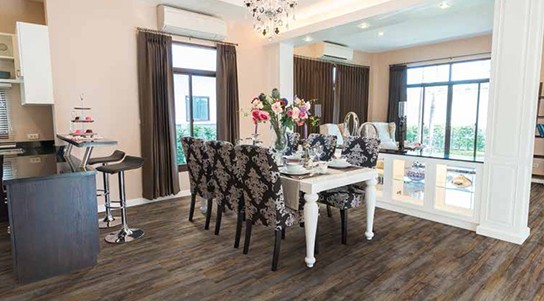
When the warmer months of the year begin to roll around there are many changes the environment goes through. But did you know that even your
flooring can be subjected to changes during these months? As heat rises vinyl flooring expands. But it isn’t just the heat within the
space but the direct sunlight that causes expansion. Too much expansion can cause the flooring to curl, peak, or buckle. You may not be able
to prevent the warmer temperatures or sunlight during these months, but there are things you can do to lessen their impact on your vinyl
plank flooring.
Visit us today to learn more from our flooring consultants.
The Vinyl Plank Comfort Zone
Vinyl plank flooring performs best within spaces that are temperature controlled. In homes, this can vary between 15°C and 30°C throughout the year. Excessive heat to the surface of your floor can cause peaks while excessive cold temperatures can make flooring brittle or stiff.
Protecting Your Flooring
To protect your vinyl from the high heat during the summer, try to keep inside temperatures relatively stable. Don’t let temperatures exceed 30 degrees. Be careful with sliding glass doors and windows because they act as magnifying glasses. This means they intensify the surface heat of the floor and can exceed 38°C. If you have glass doors and windows, be sure to use blinds and curtains during the peak sunlight hours. This will help reduce the heat radiating through the windows and doors onto the floor not to mention protect the vinyl plank flooring from becoming faded or discolored.
Control the Humidity
Humidity can take its toll on your vinyl plank flooring. Monitor humidity levels with a hygrometer. You may be able to find a relatively inexpensive one that will save you the cost of replacing your flooring later on. The humidity should range between 35 and 55% or whatever your flooring manufacturer suggests. Use a portable dehumidifier to reduce humidity when levels get fairly uncomfortable for you and your floor.
Use Door Mats at All Entrances
We’ve talked about humidity, direct sunlight, and heat, but what about the other elements that can leave your flooring in poor condition? In the summer months, there is more mud, dirt, sand, and small rocks that can end up being dragged onto your flooring. Not only will it make your flooring look dirty but it can cause little scuffs and scratches. Using doormats makes sure these natural elements stay outside where they belong and don’t become slip or tripping hazards.
Check Your Felt Tips
Though vinyl plank flooring is scratch resistant, it is still possible to damage it. When is the last time you checked the felt tips on the bottom of your furniture? Have you been using felt tips at all? Felt tips help protect your flooring from scratches and other unsightly damage caused by furniture. Felt tips do collect dirt, dust, and grit over time so you will need to change them regularly to prevent scratching the floor underneath. The more outside material you track indoors, the more likely this is to happen.
Consider LVP This Summer
Vinyl plank flooring is gaining so much popularity in the flooring world, and with good reason! It can be installed in every room of the house, is exceptionally durable, and is incredibly low maintenance. With these summer maintenance tips, you’ll be sure to keep your vinyl flooring looking great for years to come! See us in store to for more year-round LVP maintenance advice, or for help selecting new vinyl plank flooring!

